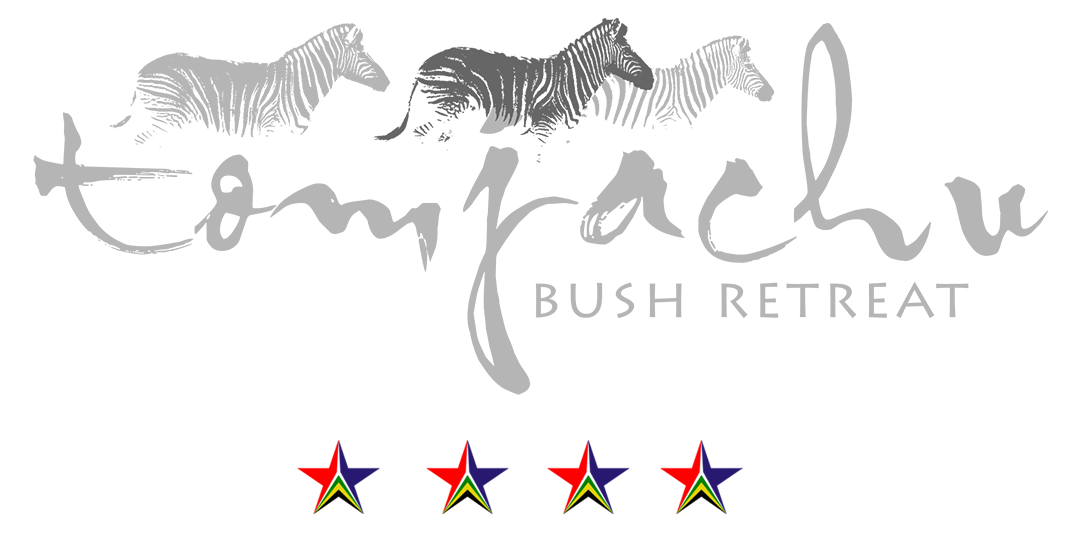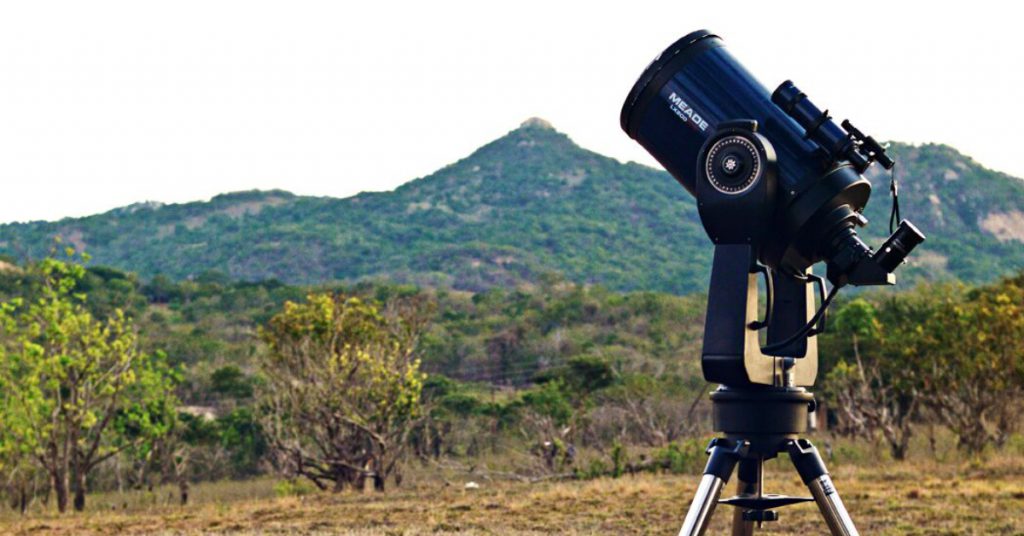
Night Sky Safari ‘Big 5’ for November
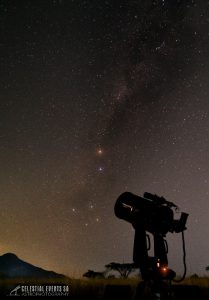
The Southern Cross from Tomjachu Bush Retreat
South Africa is world renowned for its rich and abundant wildlife but many travellers come here searching for more than just a few memorable photos. There is no denying that we live in a fast-paced and over-populated world; and that we all need our space… There is something soothing; something peaceful; about looking up on a cloudless night and losing oneself in the mysteries of the stars.
In today’s world, knowledge is everywhere for those that look for it and we have lost the need to imagine. South Africa’s unpolluted skies provide an unprecedented opportunity to lose oneself in the vastness of the night sky and dream about what possibilities may exist outside our fast-paced and saturated lives.
Despite November marking the start of South Africa’s wet season, many clear nights still abound and with them come a host of fascinating celestial phenomena to view and examine. We have chosen our Big 5 sights for you to look out for during the hours of 7pm and 10pm that should be visible from even partially dark skies. This is of course just the tip of the iceberg and a few sweeps of the night sky with a pair of binoculars will reveal a myriad of fascinating objects to explore!
Our Sister Planet
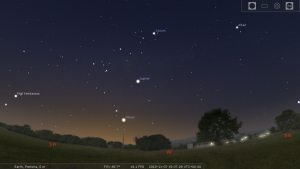
The Position of Venus, Jupiter and Saturn in November. Image Taken from Stellarium
Venus has made its return as the ‘Evening Star’ and will shine like a beacon above the western horizon for the whole month, forming a perfect line of planets with Jupiter and Saturn. Venus represents the Roman goddess of love and beauty and was named on account of its radiance. However, little did the ancients know that Venus is in fact as close to Hell than we can imagine…
Surface temperatures of over 450° that do not fluctuate be it day or night, summer or winter; an atmospheric pressure equal to that over 1 km below the surface of the ocean and corrosive sulphuric acid rain make Venus about the least hospitable place one can imagine.
Its thick clouds mean that no surface features can be seen, but even a small backyard telescope will reveal what Galileo was first to record: that Venus exhibits phases just like our Moon.
This discovery was just one of many made by the great Italian astronomer, that finally persuaded the world (and the church) that the Earth was not in fact the centre of everything.
The Spring Triangle
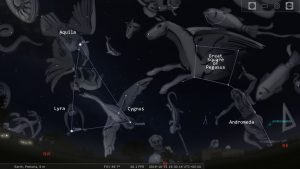
The Spring Triangle. Image Adapted from Stellarium
Above the northern horizon, 3 bright stars make an obvious triangle in the sky that are clearly visible before they begin to dip towards the horizon. Vega is the 5th brightest star in the star and is the brightest star in the constellation of Lyra that represents the harp of the great musician Orpheus whose music was said to charm even the stones of the Earth. To the east lies Deneb, the tail of the great swan, Cygnus, also known as the Northern Cross. Higher in the sky one can find Altair, the brightest star in Zeus’s pet eagle, Aquila. Once found, the triangle is obvious but due to these constellations being positioned in the northern celestial sphere, they will not be visible for long so enjoy the sight while you can!
The Andromeda Galaxy
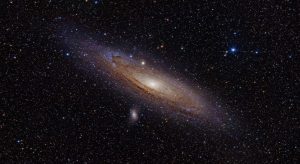
The Andromeda Galaxy. Image Credit: Wikipedia
If ever you needed proof that we are all part of something bigger; much bigger; then look above the eastern horizon after dark and find the small hazy patch of sky below the prominent 4 stars of the Great Square of Pegasus. This is the Andromeda Galaxy, our closest significant galactic neighbour and is the furthest object visible with the naked eye. Binoculars will reveal a prominent oval shaped cloud but seen with long exposure photography, it is a sight to behold.
Residing over 2.5 million light years away, our sister galaxy dwarfs our own, with its spirals estimated to contain over 1 trillion stars. Whilst we will not have to worry about it in our lifetime, this celestial behemoth is on a crash course with our Milky Way, hurtling towards us at a mind-blowing 500kms/second. When the 2 galaxies finally merge in about 4 billion years’ time they will engage in a cosmic dance and eventually settle into one giant elliptical galaxy.
The Ptolomy & Butterfly Clusters
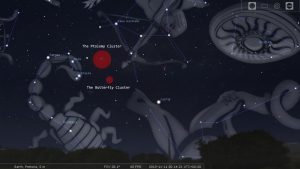
The Ptolomy & Butterfly Clusters. Image Adapted from Stellarium
The end of November will bring with it the setting of Scorpius, the giant celestial scorpion that chases Orion across the sky. While its pincers and body dip below the horizon, the 2 bright stars in its tail can point you towards 2 of the most rewarding Open Clusters in the sky. Both are visible to the naked eye but binoculars will reveal more about their true identity.
The Ptolomy cluster is the larger of the 2 and present as a beautiful grouping of 80 brilliant young stars. The smaller Butterfly Cluster is best viewed through a telescope but with binoculars, keen-eyed star gazers may be able to make up the prominent butterfly shape that gives it its name. Both are celestial nurseries containing infant stars all borne from the same collapsing cloud of interstellar gas that are beginning their own cosmic journey. In addition to being strikingly beautiful, these Open Clusters give astronomers a unique insight into the evolution of stars by comparing the individual members.
The Magellanic Clouds
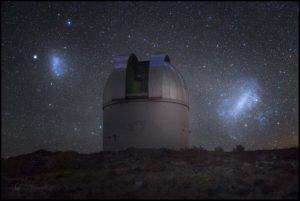
Magellanic Cloud Star Stream. Photo Credit: V.Belokurov/D.Erkal/A.Mellinger
Looking south, one may be forgiven for tutting under one’s breath upon seeing 2 small clouds in the otherwise clear sky. Do not be fooled however; these are not random meteorological phenomena but are in fact satellite galaxies of the Milky Way. Due to their position in the south of the celestial sphere, the Small and Large Magellanic Cloud can never be seen from the northern hemisphere and were only officially catalogued in the early 1500’s by the Portuguese explore, Ferdinand Magellan.
These 2 small companions have strayed dangerously close to our galaxy and have lost their classical spiral structure as they are subjected to unimaginably strong gravitational forces. Depending on their trajectory, it is likely that they will be swallowed by our galaxy, with many stars being absorbed into the Milky Way, while others will be cast out to live out their lives as lonely, isolated stars in the great expanse of space.
Recent discoveries have shown that despite being unrelated, the 2 ‘clouds’ are connected by a stream of stars 10’s of thousands of light years long caused by their interacting gravities. This gravitational struggle makes the clouds rich in telescopic deep sky objects including 47 Tucana, the 2nd brightest Globular Cluster of stars in the sky, and the Tarantula Nebula, the most active region of star formation the surrounding galaxies.
Author: Ben Coley from Celestial Events SA
